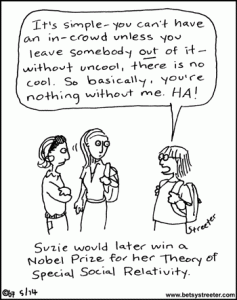Book review: Clifford Nass – The man who lied to his Laptop.
Ah, this post is tinged with both pleasure and sadness. I had originally intended this to be a book review of Clifford Nass’s ‘The Man who lied to his Laptop’. I am a huge fan of this book. It has done more to change the way I think about how we develop and interact with technology than any other single book I have read. It’s a corker. But just now, going and doing some background research – I have discovered the author died just last month and I am immensely saddened by his passing. Clifford Nass was one of those an incredible thinkers – he was always ahead of the curve in terms of our interaction with technology and he researched and wrote about topics as diverse as split-attention and multi-tasking, robots, the proliferation of screens in our lives and – most significantly for me – the little noted but hugely significant ways in which we react to technology as if it were a person. He was a Harvard Professor for more than 20 years and involved in ‘many departments – communication, computer science, education, science, technology and society, cymbolic systems and sociology’. He also spent much time consulting in the private sector working for companies like Microsoft and BMW and implementing the important findings in the real world. As such – he has always been something of a hero of mine. I’ll miss him. Vale Professor Nass.
As an aside, in light of recent research from the likes of Nicholas Carr, I am going to refrain from my usual habit of including lots of hyperlinks to every-bloody-thing that is even vaguely relevant. This is a simple article and is designed to be read in a linear manner. So there. (I will write more on Carr’s work soon).
 So, Nass’ book ‘The Man who lied to his laptop’ is terrific. It’s one of those ‘written by an academic – but for the layman books about important technology and how it affects society’ – that crowd our book-shelves nowadays. And as such it suffers a little from some of the problems common to these books, whilst still managing to transcend the form. It’s well written in a very informal ‘let me tell you this story’ tone which makes the research eminently digestible – it can be read by anyone (but don’t go looking for details of experimental design or statistical analysis here – it tends, like most of these books, to gloss over the minutae) . Much of the book is structured around specific problems or research projects, which are then expanded upon, an experiment described, and then the findings and their implications discussed. It takes you on a series of small journey’s which manage to capture the joy of discovery and the awe at the wider implications of the knowledge acquired.
So, Nass’ book ‘The Man who lied to his laptop’ is terrific. It’s one of those ‘written by an academic – but for the layman books about important technology and how it affects society’ – that crowd our book-shelves nowadays. And as such it suffers a little from some of the problems common to these books, whilst still managing to transcend the form. It’s well written in a very informal ‘let me tell you this story’ tone which makes the research eminently digestible – it can be read by anyone (but don’t go looking for details of experimental design or statistical analysis here – it tends, like most of these books, to gloss over the minutae) . Much of the book is structured around specific problems or research projects, which are then expanded upon, an experiment described, and then the findings and their implications discussed. It takes you on a series of small journey’s which manage to capture the joy of discovery and the awe at the wider implications of the knowledge acquired.
So what is the actually book about? Well the basic premise is very simple, and can be boiled down to the following: ‘People react to technology as if it were another person’. Sounds kind of daft huh? Wait for it…
 Nass starts out with the classic tale of anthropomorphism gone bad – ‘Clippy’ the animated helper in Microsoft Word 97 that became almost universally loathed and mocked and still symbolizes everything that can go wrong in human-acting agent systems. Nass was hired by Microsoft around this time to investigate why this stupid animated paper-clip was so hated and he came up with some interesting findings. Specifically, people were judging this animated bunch of pixels by the same criterion we judge other people – and the poor little dude just had no chance at all. No matter how many times you refused his help – he never learnt and kept pestering you, he never learnt your name, and no matter how you rephrased your question – he kept on providing the same unhelpful answers. At this point you’re probably rolling your eyes – yes, so what’s the point. But stay with me here.
Nass starts out with the classic tale of anthropomorphism gone bad – ‘Clippy’ the animated helper in Microsoft Word 97 that became almost universally loathed and mocked and still symbolizes everything that can go wrong in human-acting agent systems. Nass was hired by Microsoft around this time to investigate why this stupid animated paper-clip was so hated and he came up with some interesting findings. Specifically, people were judging this animated bunch of pixels by the same criterion we judge other people – and the poor little dude just had no chance at all. No matter how many times you refused his help – he never learnt and kept pestering you, he never learnt your name, and no matter how you rephrased your question – he kept on providing the same unhelpful answers. At this point you’re probably rolling your eyes – yes, so what’s the point. But stay with me here.
Similar stories abound where technology, when deliberately given human characteristics, evokes a whole range of responses that are typically reserved for other people. Another classic story that Nass relates (and was involved in) was the development of BMW’s first spoken word navigation system, where drivers would be directed to their goal by a recorded voice telling them where to go. This is a commonly-related ‘har-har’ case where the Germans are laughed – there was a massive customer backlash against the system because the human voice was female and the Germans didn’t want to take directions from a woman.
Again, this is not so suprising – it’s another example of where we have deliberately imbued technology with human qualities. But… and it gets more interesting.
Nass then details a number of experiments which build on his argument, and each one is fascinating. I will relate the one here that totally blew my mind. Nass had a bunch of participants form into two teams: blue and green. Team members were given coloured bracelets to identify themselves. Each team was then given a problem-solving task and given the aid of a computer with pre-programmed software – which they could use for certain tasks. In one condition the computer was coloured (with the aid of coloured tape around the monitor and keyboard) the same colour as the team, ie: the green team was using a green computer. In the other condition the team was given a computer with the opposite teams’ colour. The teams were told that they would be evaluated in competition with the other team based on their work and the work done on the computer. At the end of the experiment participants filled out questionnaires revealing the following:
- Participants using the same colour computer rated the information provided by the computer as more ‘trustworthy’ (even though exactly the same information was provided in both condtions).
- Participants thought the same colured computer was more ‘intelligent’.
- Participants using the same colour computer were shown to act much more in the information provided.
- Participants said that when using the same colour computer they enjoyed the task more, put more effort into working together and were more goal orientated.
Ie: As small a change as changing the colour of the computer made users feel as though the computer was a ‘member of the team’ and modified their interaction with it accordingly.
 This ties in with a long-established series of experiments in Social Psychology called the ‘Minimal Group’ paradigm (originally developed by Tajfel in 1971). Here, Tajfel showed that our identification with a group (referred to as our ‘ingroup’) – and our behaviour towards another group (the ‘outgroup’) can take place remarkably quickly and have profound impacts on our thinking and behaviour. Ingroup and Outgroup behaviour has long been noted in social psychology. We will tend to attribute more favourable qualities to our ingroup than our outgroup, we will behave better towards ingroup than outgroup members, and, interestingly, we tend to continually exhibit a classic cognitive bias called ‘Fundamental Attribution Error’. This means that we tend to think that when we see bad behaviour amongst our outgroup – we attribute this to the very nature of those people (‘Of course they would do that – they’re bad people’), whereas when we see bad behaviour from our ingroup – we attribute it to situational factors ‘Ah – that person must be having a very bad day to behave like that’). It’s a powerful and all-pervasive phenomena.
This ties in with a long-established series of experiments in Social Psychology called the ‘Minimal Group’ paradigm (originally developed by Tajfel in 1971). Here, Tajfel showed that our identification with a group (referred to as our ‘ingroup’) – and our behaviour towards another group (the ‘outgroup’) can take place remarkably quickly and have profound impacts on our thinking and behaviour. Ingroup and Outgroup behaviour has long been noted in social psychology. We will tend to attribute more favourable qualities to our ingroup than our outgroup, we will behave better towards ingroup than outgroup members, and, interestingly, we tend to continually exhibit a classic cognitive bias called ‘Fundamental Attribution Error’. This means that we tend to think that when we see bad behaviour amongst our outgroup – we attribute this to the very nature of those people (‘Of course they would do that – they’re bad people’), whereas when we see bad behaviour from our ingroup – we attribute it to situational factors ‘Ah – that person must be having a very bad day to behave like that’). It’s a powerful and all-pervasive phenomena.
So back to Tajfel. Whilst Social Psych researchers had been happily building up lots of evidence of in-group vs outgroup behaviour and applying it to everything from football matches to ethnic strife, it had always been assumed that it took a while for these identities to form. Tajfel, on the other hand, showed just the opposite. Almost ANYTHING can induce these patterns of behaviour. In an experiment he once had participants all file into a large classroom and randomly distributed a red or a blue pen to each person. Even on the basis of this completely arbitrary difference, when tested, people had (whether consciously or not) formed in-group identity and were already exhibiting all the aspects of this kind of behaviour. Hence the name ‘Minimal Group’ – it takes almost NOTHING for us to feel that a bunch of people is ‘us’ and that those people over there are ‘them’.
 And now back to Nass. ‘The man who lied to his laptop’ lays out the case, quite convincingly, that when we interact with technology, we anthroporphise it. Ie: we react to it as if it were a person – even without being aware of it – and almost constantly.
And now back to Nass. ‘The man who lied to his laptop’ lays out the case, quite convincingly, that when we interact with technology, we anthroporphise it. Ie: we react to it as if it were a person – even without being aware of it – and almost constantly.
This, of course, has HUGE implications for designing our tools since it means that we can now apply a vast body of knowledge about how we interact with other people – Social Psychology – and apply this to the way we develop our interactions with technology.
‘The man who Lied to his Laptop’ is a terrific book – and, if you’re into interaction and the User Experience – an important one. Read it.
And so long Clifford. You’ll be missed.


 Address: 11 Silva St, Tamarama, Sydney, Australia
Address: 11 Silva St, Tamarama, Sydney, Australia Phone: +61 2 (0) 404 214 889
Phone: +61 2 (0) 404 214 889 Email:
Email: 